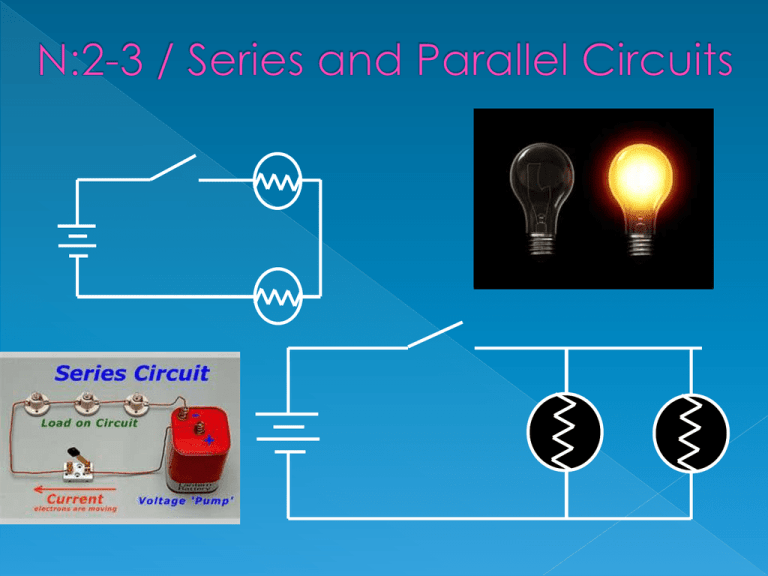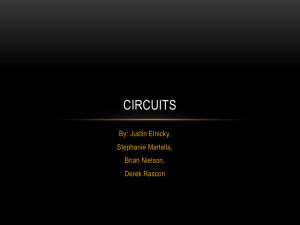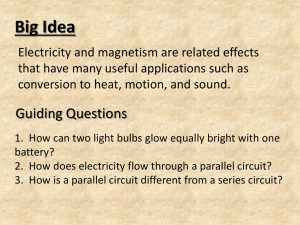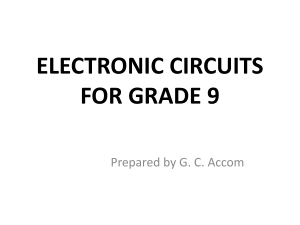N:2-3 / Series and Parallel Circuits
advertisement

It’s a cool, clear night as you stroll by the harbor with your family. The night is dark, but the waterfront is bright thanks to the thousands of twinkling white lights that outline the tall ships. They make a striking view. •As you walk, you notice that a few of the lights are burned out. •The rest of the lights, however, burn brightly. If one bulb is burned out, how can the rest of the lights continue to shine? •The answer depends on how the electric circuit is designed. •The parts of a circuit can be arranged in series or in parallel. •If all the parts of an electric circuit are connected one after another, the circuit is a series circuit. •The photo and diagram below show a series circuit. In a series circuit, there is only one path for the current to take. • For example, a switch and the device it controls are connected in series with each other. •A series circuit is very simple to design and build, but it has some disadvantages. •What happens if a bulb in a series circuit burns out? •A burned-out bulb is a break in the circuit, and there is no other path for the current to take. •So if one light goes out, all the lights go out. •Another disadvantage of a series circuit is that the light bulbs in the circuit become dimmer as more bulbs are added. •Why does that happen? •Think about what happens to the overall resistance of a series circuit as you add more bulbs. •The resistance increases. •Remember that if resistance increases, current decreases. • So as light bulbs are added to a series circuit, the current decreases. •The result is that the bulbs burn less brightly. Duracell Duracell Series Duracell Duracell Series Duracell Duracell Series Duracell Duracell Series Duracell Duracell Series Duracell Duracell Series N:2-3 / Series and Parallel Circuits •Could the lights on the ships have been connected in series? •No—if the lights were part of a series circuit, all of the lights would have gone off when one burned out. •What you saw, however, was that a few lights were burned out and the rest were brightly lit. Parallel Circuits •The ships’ lights were connected in parallel circuits. •In a parallel circuit, the different parts of the circuit are on separate branches. •The photo and diagram below show a parallel circuit. •In a parallel circuit, there are several paths for current to take. •Notice that each bulb has its own path from one terminal of the battery to the other. Parallel Circuits •What happens if a light burns out in a parallel circuit? •If there is a break in one branch, current can still move through the other branches. •So if one bulb goes out, the others remain lit. •Switches can be placed along each branch so that individual bulbs can be turned on and off without affecting the others. Parallel Circuits •What happens to the resistance of a parallel circuit when you add a branch? •Although you might think that the overall resistance increases, it actually decreases. • To understand this, consider the flow of water once again. • Suppose water is being released from a reservoir held by a dam. Parallel Circuits •If the water is allowed to flow through one pipe, a certain amount of water comes out. •But if two pipes are used instead of one, twice as much water flows. •The water will flow more easily because it has two paths to take. •The same is true for a parallel circuit. •As new paths, or branches, are added, the electric current has more paths to follow, and so total resistance decreases. Parallel Circuits •What does this tell you about current? •If resistance decreases, the current must increase. • The increased current travels along the new branch without affecting the original branches. •So as you add branches to a parallel circuit, the brightness of the light bulbs does not change. Parallel Duracell Duracell Parallel Duracell Duracell Parallel Duracell Duracell Parallel Duracell Duracell Parallel Duracell Duracell Parallel Duracell Duracell Parallel •A couple more things… •Different meters are wired into circuits in different ways. •A voltmeter is used to measure voltage. •When you measure the voltage across some device, the voltmeter and the device should be wired as parallel circuits. •An ammeter is used to measure current. •If you want to measure the current through some device in a circuit, the ammeter should be connected in series with the device. •Would you want the circuits in your home to be series circuits? •Of course you would not. •With a series circuit, all the electrical devices in your home would go off every time a light bulb burned out or a switch was turned off. •Instead, the circuits in your home are parallel circuits. •Electricity is fed into a home by heavy wires called lines. •These lines have very low resistance. •You can see in the illustration below that parallel branches extend out from the lines to wall sockets, appliances, and lights in each room. •The voltage in these household circuits is 120 volts. Switches are located in places where they can be used to control one branch of the circuit at a time. Comparison Series Circuit Parallel Circuit Only one path for Definition current to flow Multiple paths for current to flow Total resistance Resistance increases Examples -Holiday lights Total resistance stays same -Household Current









